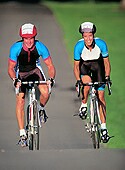
TUESDAY, Aug. 31 (HealthDay News) — The hearts of triathletes adapt to the rigors of training and competition by becoming more efficient, which suggests that combining endurance and resistance training may be the best way to achieve optimal heart health, researchers say.
German researchers used MRI to examine the hearts of 26 professional male triathletes (mean age 27.9) and a control group of 27 men who were recreationally active no more than three hours per week (mean age 27.3).
Compared to the control group, the triathletes had larger left atria and larger right and left ventricles. In addition, the triathletes’ left and right ventricles had greater muscle mass and wall thickness. A triathlon is a multi-sport competition involving swimming, cycling and running in succession.
The researchers also found that the triathletes’ resting heart rates were 17 percent lower than those of the men in the control group. This lower resting heart rate is associated with greater heart blood supply and more efficient heart function.
“The hearts of the triathletes in our study are stronger and able to manage the same workload with less effort,” lead researcher Dr. Michael M. Lell, an associate professor at the University of Erlangen-Nuremburg, said in a Radiological Society of North America news release.
The study is published online and in the October print issue of the journal Radiology.
“The cardiac adaptations in the elite triathletes we studied were characterized by a balanced increase in left and right ventricular muscle mass, wall thickness, dilation and diastolic function,” Lell said. “These adaptations reflect the nature of triathlon training, which has both endurance and resistance components.”
Endurance training includes activities such as running and swimming, while resistance training includes weightlifting, and cycling combines both endurance and resistance, Lell explained. Excessive training in either resistance or endurance pursuits leads to specific heart adaptations, and extreme endurance training is believed to be linked with an increased risk for sudden cardiac events.
More information
The U.S. National Heart, Lung, and Blood Institute offers a guide to physical activity.

